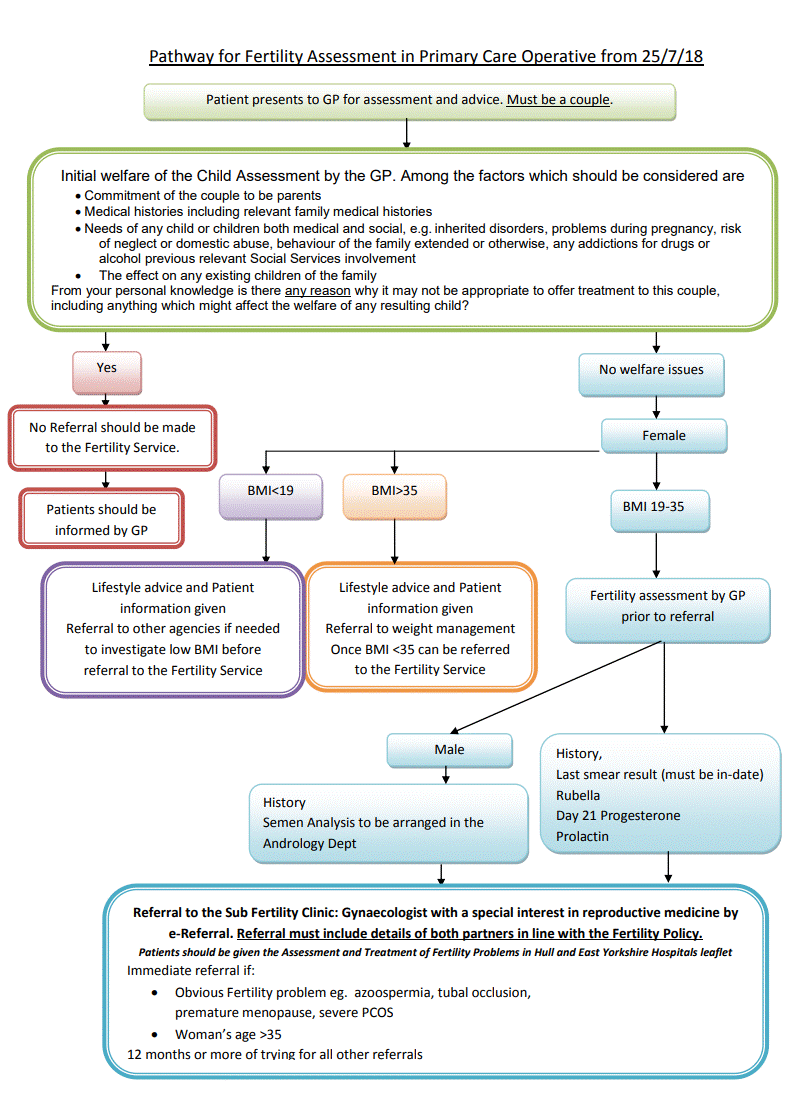Subfertility
Definition/Description
The pathway will ensure that couples who are having fertility problems are seen in a timely manner by a fertility specialist team, where a gynaecologist with a special interest in reproductive medicine manages their care.
The Fertility Service will only accept routine referrals from couples once they have been trying to achieve a pregnancy for over 12 months that have no welfare of the child issues.
Red Flag Symptoms
Exclude Red Flag Symptoms
An immediate referral to the service should be made to the service if:
- The couple have obvious fertility problems eg. Azoosperima, tubal occlusion, premature menopause, severe polycystic ovary syndrome
- If the woman’s age is above 35 years of age she must be referred immediately
If the male partner has a sperm problem the couple should be referred to the Fertility Service rather than a Urologist in the first instance. A referral directly to Urology will result in delays for the patients’ treatment in some cases.
Red Drug
Ovulation induction with Clomiphene Citrate should only be prescribed under the care of a Fertility Specialist in Secondary Care where the patients’ dose can be monitored each cycle to ensure it is within therapeutic levels. For safety reasons it should not be prescribed in primary care.
Blood Tests - GP Guidance
For this to work in practice the GPs need to order and perform the correct Hepatitis and HIV tests needed by law.
Those are:
- HIV 1 and 2: Anti-HIV – 1, 2
- Hepatitis B: HBsAg and Anti-HBc (Core antibody and Surface antigen)
- Hepatitis C: Anti-HCV-Ab
Guidelines on Management
Women intending to become pregnant should be informed that dietary supplementation with folic acid before conception and up to 12 weeks' gestation reduces the risk of having a baby with neural tube defects.
Patients should be given advice about lifestyle and how this can affect fertility e.g the effects of smoking, drinking alcohol, high BMI , low BMI, wearing tight underwear.
- Patients who smoke should be referred to smoking cessation programs.
- Women who have a BMI of less than 19 and who have irregular menstruation or are not menstruating should be advised that increasing body weight is likely to improve their chance of conception.
- Men should be informed that there is an association between elevated scrotal temperature and reduced semen quality, but that it is uncertain whether wearing loose-fitting underwear improves fertility.
- Men who have a BMI of 30 or over should be informed that they are likely to have reduced fertility.
- Women who have a BMI of 30 or over and who are not ovulating should be informed that losing weight is likely to increase their chance of conception.
People who are concerned about their fertility should be informed that vaginal sexual intercourse every 2 to 3 days optimises the chance of pregnancy
Referral Criteria/Information
Do Not Refer
A referral should not be made unless the GP has made a Welfare of the Child Assessment to rule out any issues that may affect the welfare of any child born as a result of fertility treatment, among the factors which should be considered are:
- Commitment of the couple to be parents
- Medical histories including relevant family medical histories
- Needs of any child or children both medical and social, e.g. Inherited disorders, problems during pregnancy, risk of neglect or domestic abuse, behaviour of the family extended or otherwise, any addictions for drugs or alcohol previous relevant Social Services involvement
- The effect on any existing children of the family
The GP should not refer the couple if there are concerns about the welfare of any child that may be born as a result of the treatment
- Only refer couples to the service, single men or women should not be referred
- Couples where the woman’s BMI is greater than 35 should not be referred. Referral to weight management should be made and lifestyle advice given. The couple can be referred to the Fertility Service once the woman’s BMI is less than 35
- Couples where the woman’s BMI is less than 19 should not be referred. In the first instant a referral to other agencies to investigate low BMI should be made. Only when a root cause is explored and ruled out can the patient be referred.
Only refer couple that have had initial investigations of Prolactin and Progesterone, Rubella immunity confirmation, and a semen analysis. A history and smear test result including the date are also needed.
Referral Criteria
Please refer to the additional document Pathway for Fertility Assessment in Primary Care for guidance.
A welfare of the child assessment must have been made by the referring GP prior to referral to the Fertility Service.
- Female partner must be under 42 years of age, with BMI 19 to 35.
- Last cervical smear must be in-date, the woman must be rubella immune or have been immunized. She must have had a progesterone and prolactin blood test 7 days before an expected period (around day 21)
- Male Partner must have had a semen analysis
Referrals
Referrals will be accepted by e referrals. The referral should include the results of Prolactin and Progesterone Hormones, Rubella immunity confirmation, Smear test result including the date and a semen analysis and a short history for both partners.
Additional Resources & Reference
Welfare of the Child Assessment Form for the Subfertility Clinic.
Please see ‘Pathway for Fertility Assessment in Primary Care’ and ‘Assessment and Treatment of Fertility Problems in Hull and East Yorkshire Hospitals’
Any Other Information
All patients referred to the Fertility Service will be given a copy of the leaflet ‘Assessment and Treatment of Fertility Problems in Hull and East Yorkshire Hospitals’
Associated Policies
Places covered by
- East Riding
- Hull
Hospital Trusts
- Hull University Teaching Hospitals
